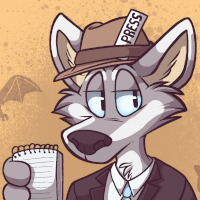The Big Bad Fox, by Benjamin Renner – Book Review by Fred Patten
by Patch O'Furr
Submitted by Fred Patten, Furry’s favorite historian and reviewer
 The Big Bad Fox, by Benjamin Renner. [Translated by Joe Johnson.] Illustrated.
The Big Bad Fox, by Benjamin Renner. [Translated by Joe Johnson.] Illustrated.
NYC, First Second, June 2017, trade paperback $15.99 (187 pages), Kindle $9.99.
Benjamin Renner is a French animator and cartoonist. He first became known in America as the co-director of the 2012 Belgian animated feature Ernest & Célestine, released in America in 2013. That was an adaptation of Belgian children’s books by Gabrielle Vincent, and featured Vincent’s art style. It was an international animation festival favorite, winning many awards, and was a 2014 Oscar Best Animated Feature nominee.
In 2015 Renner began to develop Le Grand Méchant Renard, a cartoon idea for a series of three French half-hour TV specials in his own art style. He wrote and drew his own cartoon-art book to promote them, published by Delcourt in January 2015. The TV cartoon specials grew into an 80-minute theatrical feature, Le Grand Méchant Renard et Autres Contes … (The Big Bad Fox and Other Tales …), released in France on June 21, 2017.
Now Renner’s French book has been published in English as a trade paperback by First Second Books, an American publisher of literary graphic novels.
The main characters in The Big Bad Fox are the title fox, a wimpy loser; the fearsome Mr. Wolf; what Amazon calls an idiot rabbit, a gardener pig, a lazy guard dog, and a typical hen who organizes the other hens into The Fox Exterminators’ Club; and the three little chicks that the fox becomes the Mommy of.


 A Dog’s View of Love, Life, and Death, by J. R. Archer
A Dog’s View of Love, Life, and Death, by J. R. Archer ArCANIS: A Modern Animal Tarot, by David DePasquale. Illustrated.
ArCANIS: A Modern Animal Tarot, by David DePasquale. Illustrated. Avaritia: A Fable, by M.D. Westbrook
Avaritia: A Fable, by M.D. Westbrook Garbage Night, by Jen Lee. Illustrated.
Garbage Night, by Jen Lee. Illustrated. Tucker Grizzwell’s Worst Week Ever, by Bill Schorr and Ralph Smith
Tucker Grizzwell’s Worst Week Ever, by Bill Schorr and Ralph Smith
 De Cape et de Crocs. Acte 12, Si Ce N’Est Toi…, by Alain Ayroles & Jean-Luc Masbou.
De Cape et de Crocs. Acte 12, Si Ce N’Est Toi…, by Alain Ayroles & Jean-Luc Masbou. MoonDust: Falling From Grace, by Ton Inktail
MoonDust: Falling From Grace, by Ton Inktail Murrin Road, by L. B. Kitty
Murrin Road, by L. B. Kitty